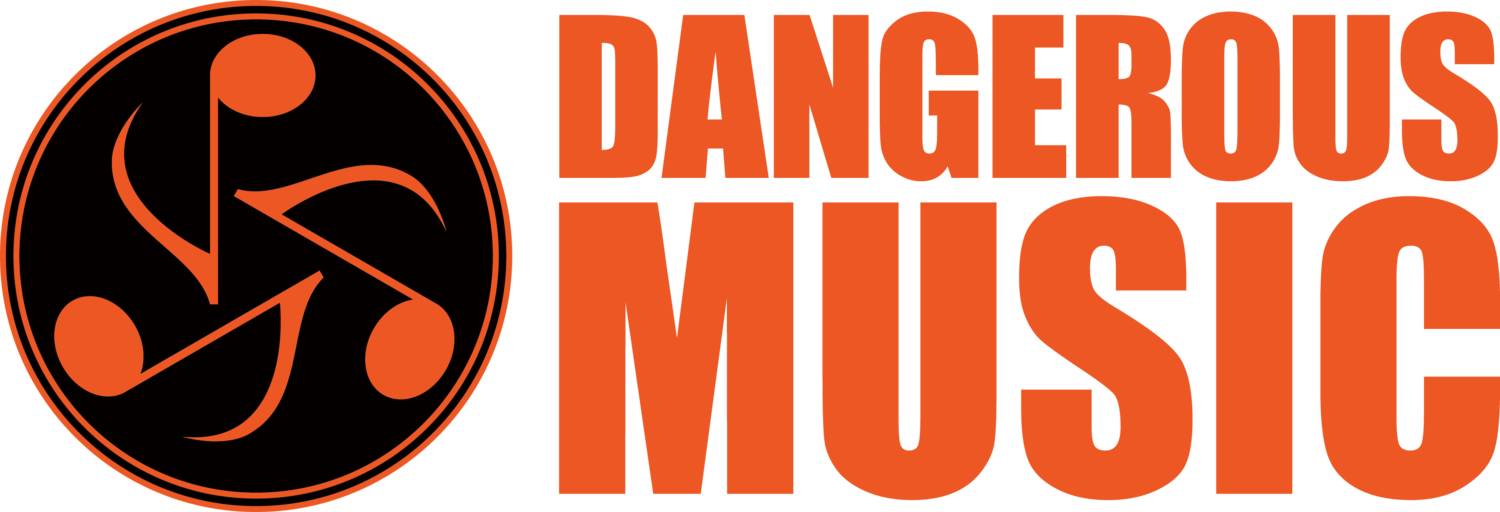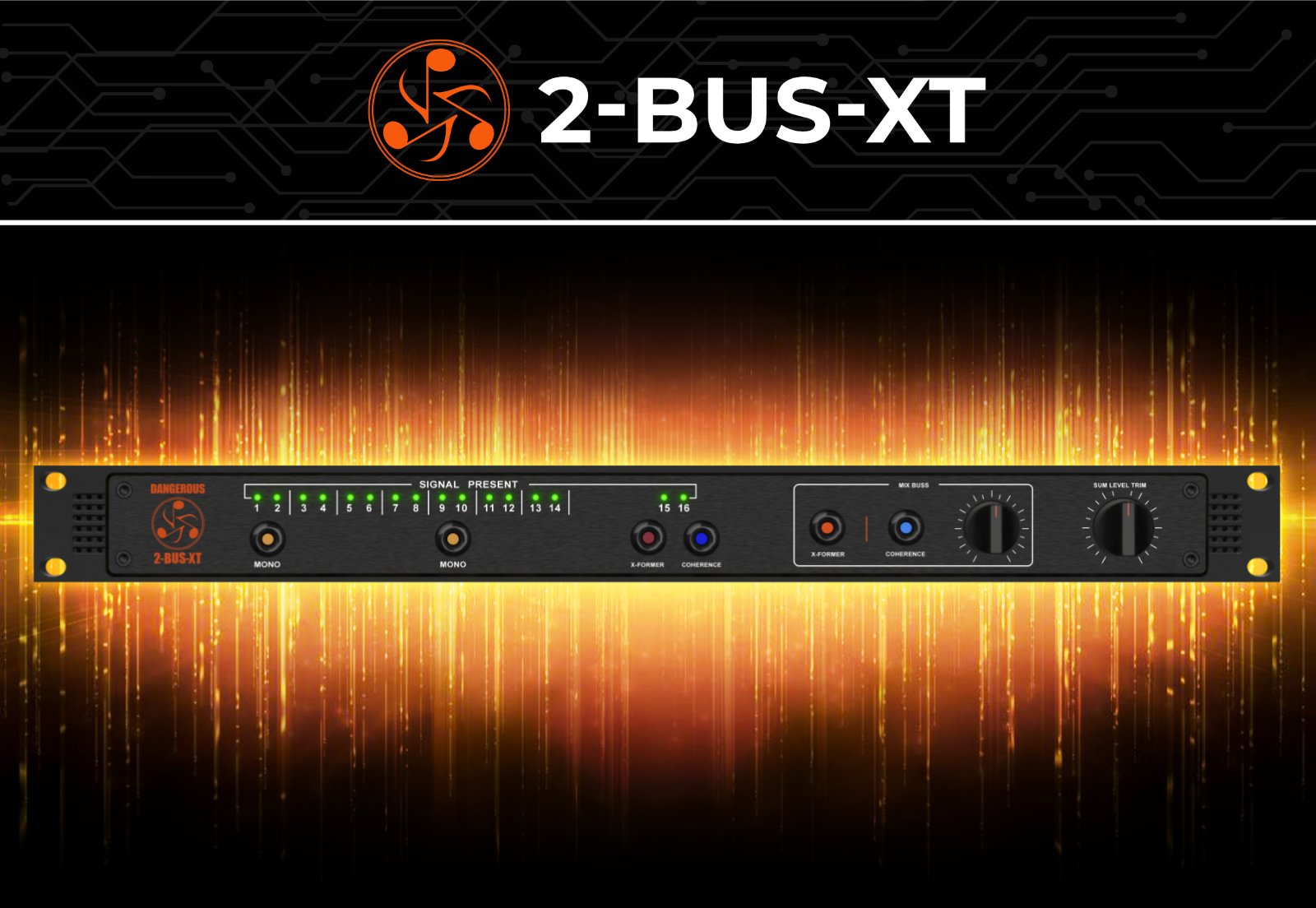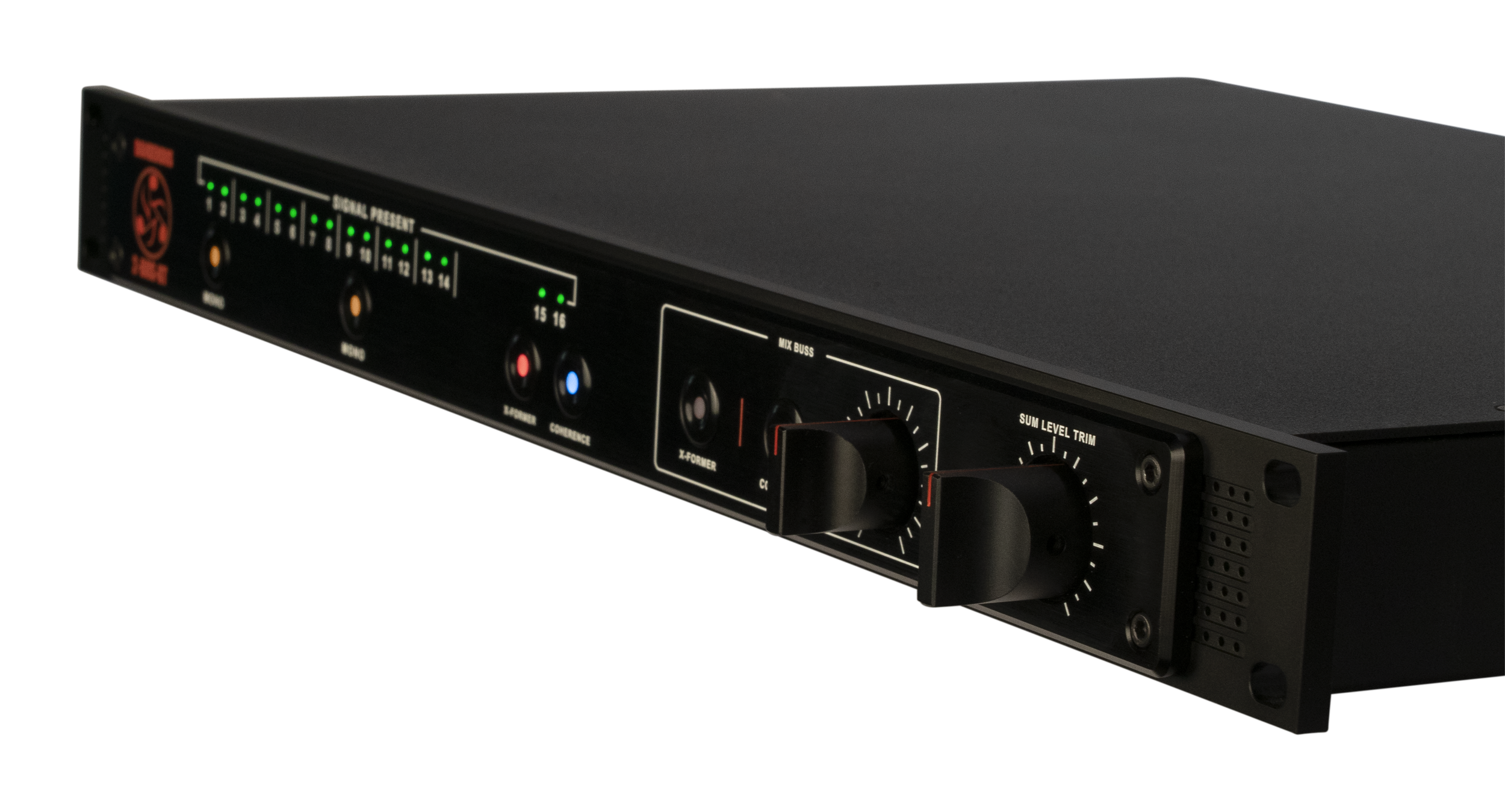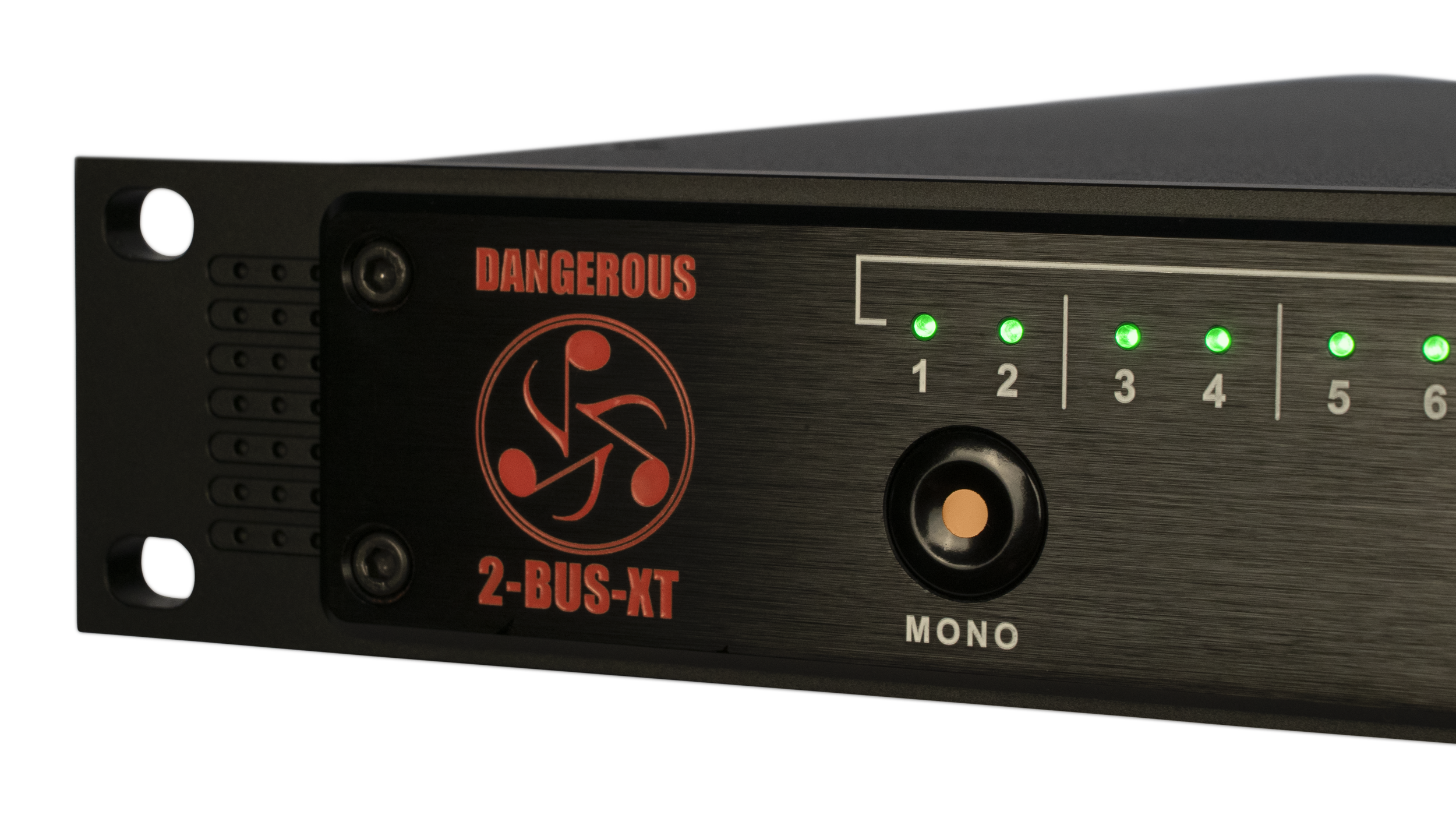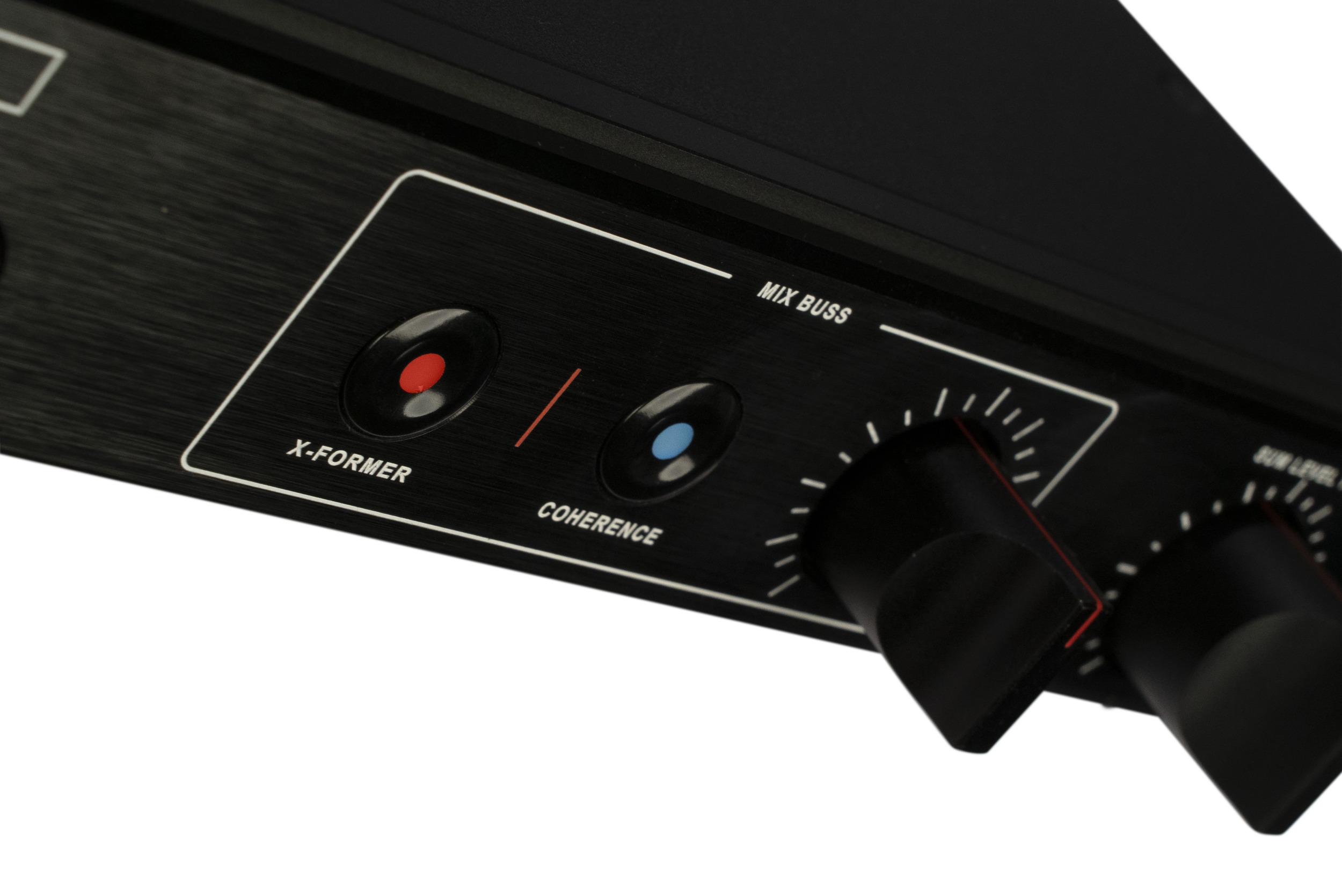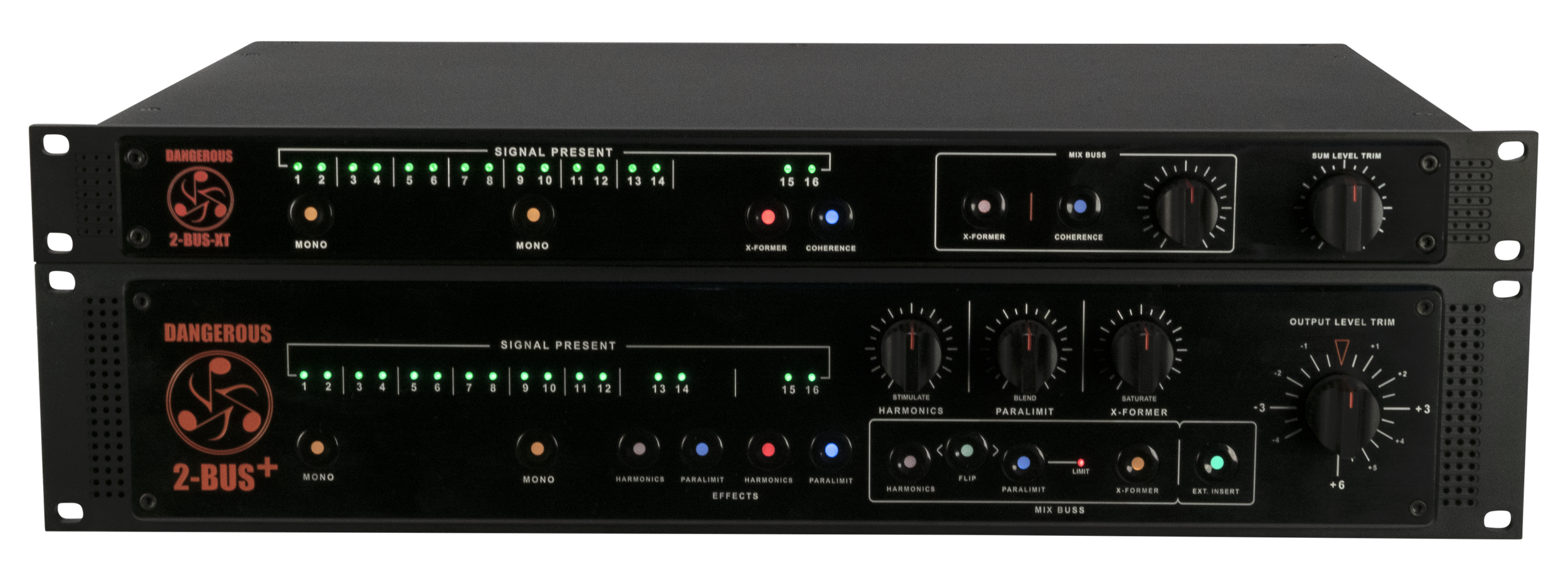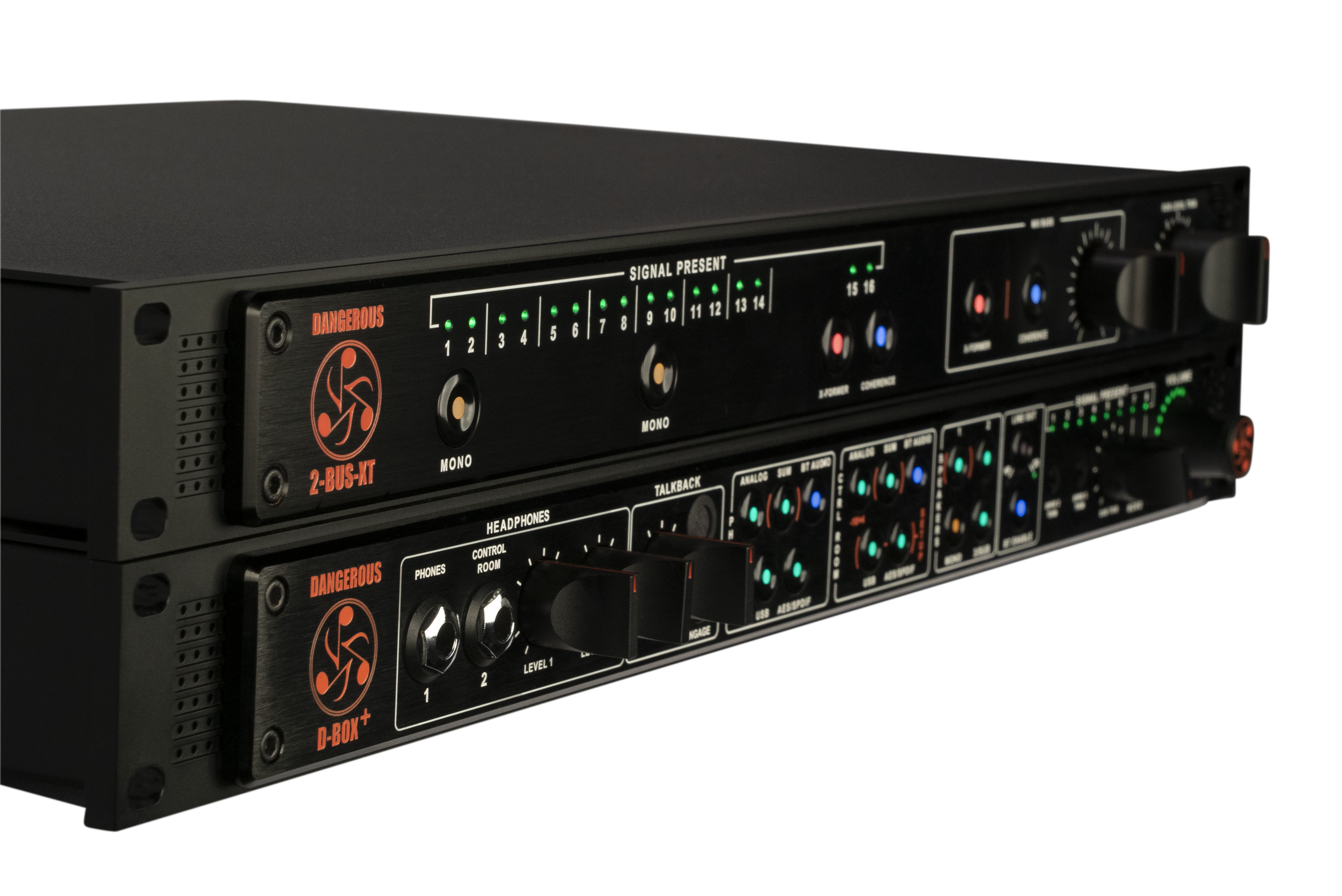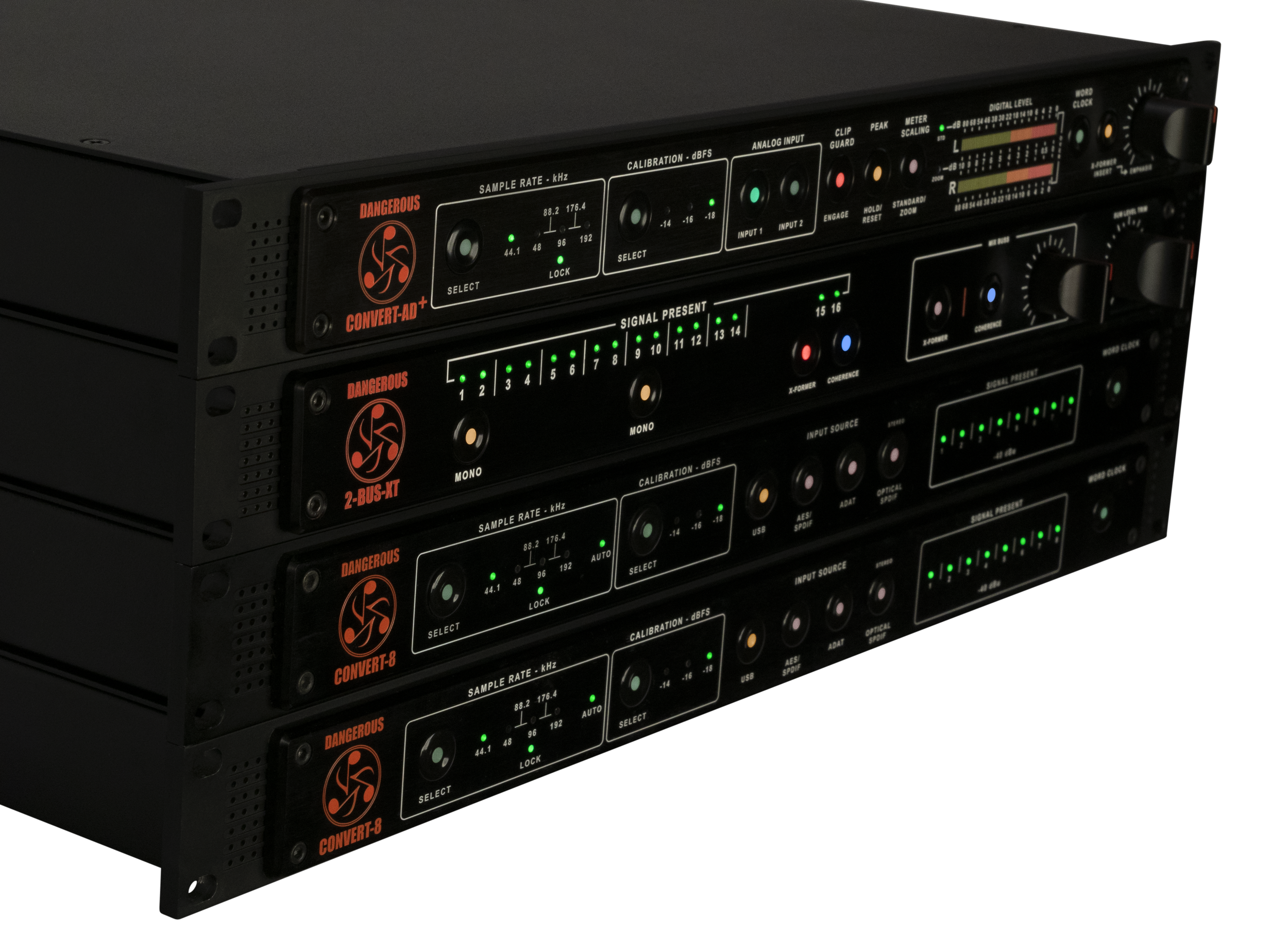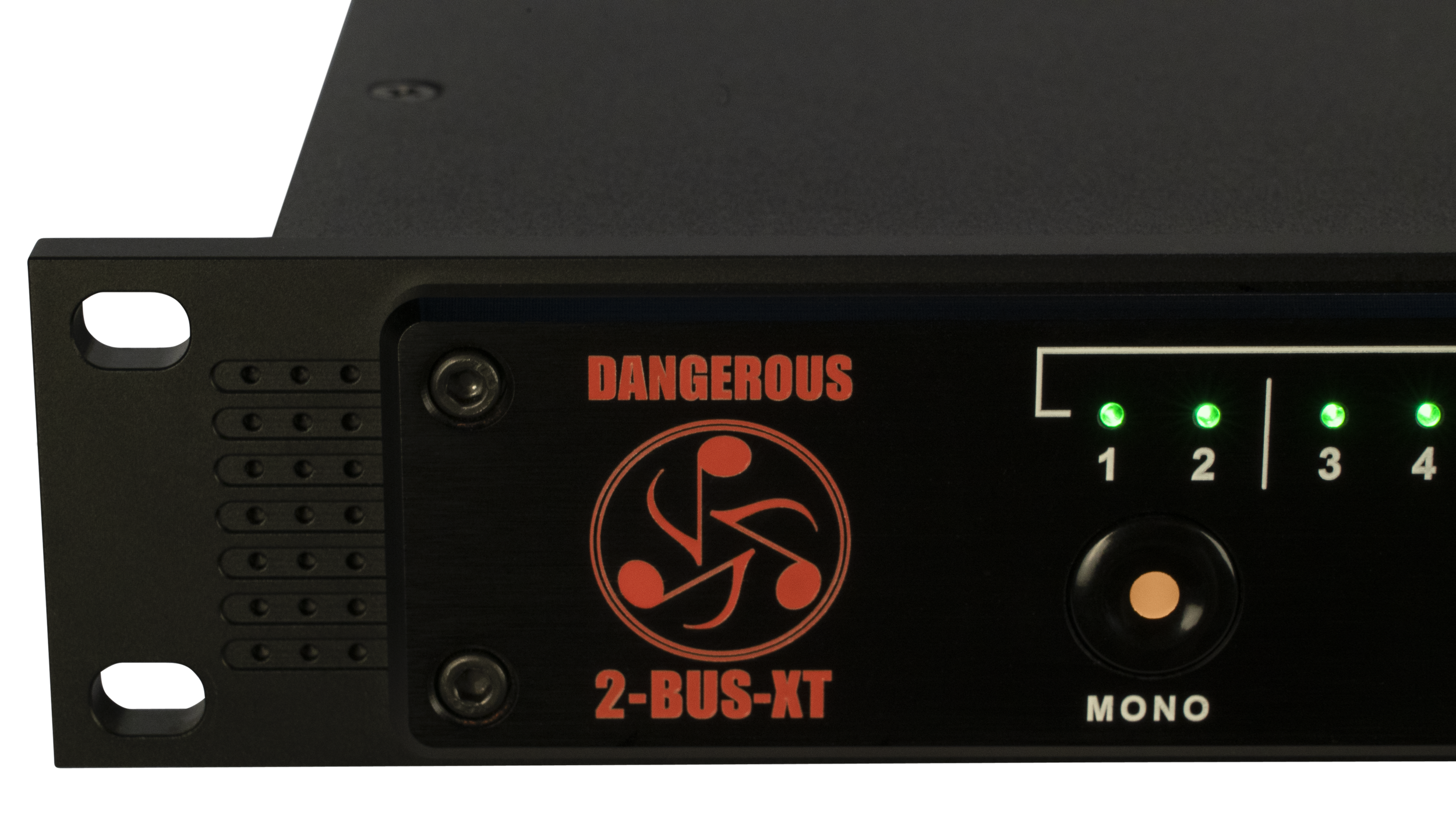the world’s FINEST analog sound within ANYONE’S reach
The totally re-engineered 2-BUS-XT delivers knock down kicks, vocals welded to the center, spacious sound stage, and an ultra high resolution depth of field that reveals everything, ultimately gluing your tracks together organically & effortlessly. You’ll experience the pleasure of mixing it better and faster with fewer plug-ins.
Leveraging the unsurpassed six layer board summing circuitry of the 2-BUS+, you’ll feel the legendary headroom alongside two unique custom color circuits designed by analog cause célèbre, Chris Muth.
After dozens of listening trials, the transformers were specifically chosen to add a tasteful hit of 2nd order harmonics for lower midrange warmth while preserving top-end clarity.. Perfect for adding complexity to sterile tracks that draw the listener in deep.
Coherence elevates the harmonic content of signals progressively by bringing up the detail as the levels are reduced, then allowing you to blend this result with the source mix, parallel compression style. Ride it during the hooks to add excitement and dimensional asymmetry.
Assign none, either or both to channels 15-16 or the mix buss all on true hard wired bypasses and breathe your music’s analog soul to life.
FEATURES
Hand built in the USA
Active analog summing circuits by renowned designer Chris Muth
Super wide stereo imaging (crosstalk -109dB @ 1kHz) good luck finding crosstalk specs published by other companies
Major headroom for any DAC (+27 dBu max input level)
Effortless analog outboard gear integration
Compact, single rack space
Now through January 1, 2024, we are offering discounts on new 2-BUS+ or 2-BUS-XT analog summing mixers or D-BOX+ studio monitor controllers when you trade in your working 2-BUS-LT or legacy silver face D-BOX unit.
UNVEIL YOUR SOUND WITH ACTIVE ANALOG SUMMING
Unlike passive summing boxes that require huge amounts of make-up gain to restore the lost audio, or line mixers with volume and pan pot controls masquerading as “summing mixers” the active electronics in the 2-BUS-XT result in what Dangerous users describe as “a huge soundstage,” “holographic sound,” and “audible three-dimensionality.” Panning is wide and precise, reverbs spacious and deep, bass powerful and engaging, treble and mids articulate and interesting. And within all that spacious sound, you get an incredibly focused and strong center image. When summing in analog, you’re also allowing multiple converter channels to share the workload, thereby lowering the strain and increasing their efficiency- much like a 16 lane highway vs 2 lanes. Once there, the 2-BUS-XT’s exceptional summing circuits will provide all the headroom plus a vast soundfield, allowing your mixes to truly shine.
EMULATION IMPOSSIBLE
Many analog processors – from delays and reverbs to EQs, compressors and more – have been modeled in the digital realm, but analog summing remains impossible to emulate digitally. Summing is not designed to “give you the character of a console” as many analog and digital recreations mistakenly promote, but to give you the sonic benefits and beyond. We’ve all experienced the frustration of a mix collapsing when relying on a single digital master fader to handle it all. The middle gets crowded, panning becomes blurry, reverbs lose dimension, and soon the mix just won’t hit. By summing individual tracks or subgroups of tracks (often called “stems”) with the 2-BUS-XT’s analog circuits, you get crystal clear sonic imaging and a wide-open soundstage. No matter how high your track count, all your recorded audio, software instruments, samplers, effects and plugins will sing with the detail, punch and clarity that only real analog summing can deliver. You’ll work faster, use less plug-ins and have fun.
MAKING THE ANALOG INVESTMENT
When you buy analog equipment, you’re making an investment that will hold its value for decades. Analog technology is time-tested. It won’t require an expensive upgrade, become incompatible with your computer or DAW, or start crashing. No matter what music production system you’re using in ten, fifteen, twenty years, the superior summing capabilities of the 2-BUS-XT will always be a relevant, compatible and valuable centerpiece in your studio.
PRIMED FOR EXPANSION
The 2-BUS-XT is sonically and ergonomically primed by intentional design to increase the reach of your Dangerous System.
Multiple units may be stacked for higher channel counts or team it up with the 2-BUS+ for a total of five different color circuits or the D-BOX+ to add comprehensive monitor control. From conception, to astute design, to field testing by our Platinum Legacy Crüe, the 2-BUS-XT will breathe your music’s analog soul to life.
CHOOSING YOUR SUMMING AMP:
Since the creation of the Dangerous 2-BUS many manufacturers have released “summing box” products. Choosing one can be confusing, but if you ask 2 questions it becomes easy.
+ 1. IS IT REALLY A SUMMING AMPLIFIER, OR IS IT A LINE MIXER?
A true summing box designed to be a back-end for a DAW mixer will be “fixed gain and fixed pan,” because the fader and pan controls are in the DAW software mixer. You do not want to repeat these functions in the hardware because [A] you lose your recall capabilities and [B] you are running your audio through unnecessary electronics which will degrade the sound.
If it has pan pots and/or level controls on it, it is a line mixer, not a summing mixer, despite what the front panel might say. A line mixer is perfect if you need to sub-mix keyboards or a bunch of mic preamps to stereo, but is not the best option when mixing a track from your DAW.
+ 2. DO I WANT A CLEAN OR COLORED SIGNAL PATH FOR MY MIXING?
You want options. Many manufacturers have a color signature to their sound, incorporating components like transformers or tubes into the design. These components can sometimes shape the sound in a pleasing way, but you are trapped with that sound for everything you do. We chose to make the tone and color optional with the 2-BUS+ by designing three original analog color circuits that can be selected and adjusted as you need them. Say the transformer rips on one song, but isn't right on another– simply disengage it with the press of a button. Or suppose you like the harmonics, but want less of it. Other summing amps do not have these options; don't be a hostage to a single sound. That's why you see Dangerous summing in the GRAMMYS for Jazz, Hip Hop, Metal, Pop... you are the captain of your sound.
A true mastering-grade summing amp allows everything you record to come through in its clean, high-headroom environment. We at Dangerous have a deep foundation in designing and building mastering consoles and monitor controllers. With our approach to summing you can insert color where, when and how you choose with the onboard processors in the 2-BUS+, or with outboard gear and plug-ins. All options remain open, all options remain yours- the best of all worlds.
+ A NOTE ON PASSIVE SUMMING:
There are two types of passive summing devices: powered and non-powered. Non-powered summing amps simply employ a resistor network feeding a pair of busses. This process by its nature loses a considerable amount of level, requiring a high-gain amplifier (microphone preamplifier) to bring it back up to usable line level. Non-powered boxes require the user to insert a separate outboard mic pre for this makeup gain.
Other products have the amplifier built in, appearing on the outside like an active summing device but in fact employ the same non-powered summing as described above. You can often tell when non-powered summing is being used by a high input channel count (32 or 48 inputs) because the parts cost only pennies, as opposed to having expensive active receiver amplifiers on every input.
We have found through years of experience and testing that this non-powered approach is not the ideal way to handle this task, and that an active design using balanced receiver amplifiers, summing op-amps and line drivers yields the most exceptional performance.
Not having an active balanced design creates several potential problems:
• A balanced receiver provides common mode rejection (CMR) while a passive resistor network does not. Good CMR is key to low noise performance.
• A balanced receiver allows isolation of the D/A converter’s ground from the audio ground of the summing amp – passive does not. This could lead to poor crosstalk rejection, which means poor imaging.
• Active design also allows for a local ground reference for the inputs, which is the same ground reference as the summing op-amp. All these things contribute to a clean, quiet, low-distortion device that is stable.
HOW IT WORKS
+ LEARN THE PROCESS
By routing individual mono tracks or panned stereo subgroups to the 2-BUS+, you get the benefits of both analog tone and DAW automation. Route your elements out of the DAW via multiple converters, and build your mix from the ground up while listening through the 2-BUS. You will hear more detail, resulting in a better and faster mix.
The first thing you’ll need to do within your DAW is to set up multiple hardware outputs from your digital-to-analog (DA) converters, and lose your software Master Fader. Replace the Master Fader with a stereo Audio Track named 2-BUS+ Mix. (Eventually, before printing the various mixes or stems, you will rename the “2-BUS Mix” track to reflect the song title.) Patch the main output of the Dangerous 2-BUS+ (“D2B”) to a pair of analog-to-digital (AD) converters, i.e. Input 1-2, and set the input of “2-BUS+ Mix” to Input 1-2. Set this new stereo audio track to “input-monitor” so that you can hear the output of the 2-BUS+. This track is where you will record your mix.
Next you will need to route your individual tracks, returns and submixes to various DA outputs that are connected to the 2-BUS’s 16 inputs. Prior to mixing OTB, all your outputs within the DAW were probably set to Output 1-2, but that will no longer be the case. Assigning multiple outputs allows you to take advantage of the 2-BUS’s analog summing. Spreading your tracks across more DAs means that each DA has fewer elements to calculate, in layman’s terms ensuring that each instrument or vocal has maximum DA power available to it.
At this point, you are likely to hear some of the benefits of OTB analog summing, relative to digitally summing ITB. But you’ve only scratched the surface of the possibilities.
You can expand your mixing horizons by using a patchbay to integrate outboard gear as a non-destructive insert between the DA and the 2-BUS inputs, as well as between the 2-BUS Main Out and your mixdown destination, i.e. 2-BUS+ Mix.
We’ll illustrate two radically different stylistic approaches to routing. They are both equally valid, yet are capable of producing radically different aesthetic results. For the sake of simplicity, we’ll call the two approaches “Hi-Fi” and “Power” routing.
The following is an example of an effective “Hi-Fi” routing for modern mixes when using a single Dangerous 16 Channel 2-BUS:
- Kick Drum bus (mono)
- Snare Drum bus (mono)
- Drums bus (minus kick & snare) left
- Drums bus (minus kick & snare) right
- Guitar bus left
- Guitar bus right
- Background Vocals bus left
- Background Vocals bus right
- Bass bus (mono)
- Lead Vocal (mono)
- Keyboards bus left
- Keyboards bus right
- Horns & Strings bus left
- Horns & Strings bus right
- FX returns left
- FX returns right
You can further control the submixes by adding EQ and dynamics processing to the signal path in between the DA converters and the inputs to the 2-BUS+.
Here’s a very basic example of an effective “Power” routing inspired by Michael Brauer’s “Multi-Bus” mixing technique. Even an eight-input mixer like the one on the Dangerous D-BOX+ can accommodate a simple, yet very powerful, version of this technique:
- 1-2. All Vocals stereo bus
- 3-4. All Bass & Drums stereo bus
- 5-6. All Guitars, Keyboards, Horns & Strings stereo bus
- 7-8. All FX stereo bus
- 9-10. available
- 11-12. available
- 13-14. available
- 15-16. available
The “power” of this particular routing lies in the fact that you can easily “insert” stereo processing on each of the submixes in between the DA and the 2-BUS+. Thus you can optimize the processing for each group of vocals or instruments so that they will not be negatively influenced by the other groups.
Needless to say, you can mix and match the two routing approaches described above. Solve sonic problems or expand your creative horizons–the choice is yours.
Of course, you can adapt the routing to suit your needs, and you can seamlessly link any combination of up to eight 2-BUS+ or 2-BUS-XT units to create a 128 in by 2 out analog summing mixer.
Documenting and precisely recalling your settings is a breeze, since the automation is in your DAW.
+ WHY SHOULD YOU CARE ABOUT ANALOG SUMMING?
Mixing “in the box”–aka “ITB”–has been noted by many users as having apparent limitations, which are commonly described as “lack of headroom,” “poor spacial imaging,” “loss of low level detail,” and “inadequate preservation of transients.” Much like traditional consoles brought together multiple streams of audio from a multi-track tape machine, the 2-BUS+ series receives 16 analog outputs from any audio interface and combines them to stereo. It performs this transparently, without transient suppressing or bandwidth limiting components in the signal path, and is tooled specifically for the DAW environment. By spreading the track load across multiple digital-to-analog (D/A) converters and summing them in the analog domain, the 2-BUS delivers mixes that sound and feel as if they were mixed on a large-format analog console, without all the drawbacks that come with owning a console. (Price tag, electric bill, maintenance, additional air conditioning requirements...)
The 2-BUS system allows you to spread your DAW’s workload across multiple D/A converters instead of using the internal stereo mix buss of the DAW (master fader.) Whether or not you choose to integrate analog outboard gear, this process distributes the workload over multiple converters, enabling each D/A or stereo pair of D/A’s to dedicate its full potential to a single track or instrument, or a subgroup of just a few tracks. The final, ciritical step of summing to stereo occurs in the 2-BUS+’ high-headroom analog environment as opposed to occurring digitally in a computer. Transparent mastering-quality design and components preserve transient response and allow the artist or engineer to choose when, where, and how to color any individual track, stereo pair, or the entire mix with selected outboard gear without clouding the issue. If the summing amp itself has a lot of tonal coloration it is inherently limiting to the creative process, because if the color is not right for a particular project or song you cannot remove it. In short, the Dangerous 2-BUS is the right choice to retain the purest, undistorted transient response, clarity and dynamics from your recording while maintaining the fast DAW workflow and recall capabilities required by today’s mix specialists.
+ WHEN IS A “SUMMING BOX” NOT A SUMMING BOX?
A true summing device (or summing amplifier) is designed as the back-end for a DAW software mixer. It performs one very essential function: summing multiple channels of audio to stereo. A line mixer or console on the other hand performs several tasks- summing, level balancing (faders), spatial placement (panners), and aux routing of tracks. To put it simply, if it has a level control and/or a panner on the inputs it is a line mixer, not a summing amplifier. These functions are already happening in the DAW, so repeating them in the hardware domain on the back-end is detrimental for 2 primary reasons-
- Instant Recall capability is lost.
- Running your audio through unnecessary components compromises the signal path.
For these reasons, Dangerous summing amplifiers are the ideal devices for incorporating this hybrid process into your setup, whether it is a home/project studio, a travel rig, or a Grammy winning multi-room facility.
+ WHY DO THE BEST MIXING ENGINEERS CHOOSE DANGEROUS SUMMING?
Top remixers like Junior Sanchez, Producers like Duncan Sheik, Charlie Peacock and Billy Mohler, and Platinum mix engineers such as David Kahne, Richie Biggs, and Michael James have told us that they rely on Dangerous summing as an integral part of their studios because it helps them “work faster, get better sounding mixes, easily integrate analog outboard gear without latency or extra A/D/A conversions, and improve workflow efficiency.” Although they have very different approaches to creating world-class tracks, the 2-BUS+ is flexible enough to integrate seamlessly into each of their workflows: Kahne daisy-chains four units for a 64 x 2 mixer, with all his DAW outputs and his analog outboard gear permanently normaled together; James uses 2-Busses for pristine “uncolored” submixes that pass through analog processing en route to the final stereo mix. Sheik prefers the 2-BUS for it’s transparency and its ability to let him work rapidly, and Mohler finally has the bass response he’s been looking for with his D-BOX+’s eight channels of summing. Whatever the scope of your needs, we have the right tools for you.
All summing mixers are not created equal. The Dangerous 2-BUS was the first and is still the best at what it does: restoring nuance, depth and clarity to your mix without leaving a heavy sonic thumbprint. The 2-BUS-XT and D-BOX+ carry on the legacy using the same great design and components with different feature sets to serve your personal needs and your budget.
SPECS
Frequency Response:
+- 0.1dB from 20Hz-50kHz
Total Harmonic Distortion:
0.004% in audio band
Intermodulation Distortion:
0.004% IMD60 4:1
Crosstalk @ 1 kHz:
-109 dB
Noise floor:
-82 dBu total energy in audio band
Max level:
>+27 dBu
Nominal operating level:
+4 dBu
Input impedance:
12 kohm balanced
Output impedance:
50 ohms balanced (600 ohm drive capable)
Power consumption:
25 watts
DOWNLOADS
MANUALS
OTHER
SETUP DIAGRAMS
VIDEOS
Warranty:
Free 2 year extended warranty with online registration.
Standard Warranty:
90 days parts and labor, subject to inspection. Does not include damage incurred through abusive operation or modifications/attempted repair by unauthorized technicians.
TESTIMONIALS
JACK • ENGINEER
“I bought a bunch of gear, which got me to 80%. Then I researched this little gem out, and the rest is analog history for me. It’s like I poured glue all over my mixes. Fat, Warm, Depth, Clarity and Punch. Did I mention Fat? All I can say is the Dangerous 2-BUS LT is an awesome piece of gear.”
JOSH HAYWARD • ENGINEER/A&R, ASTRAL PLANE STUDIOS
“Everyone is loving the LT. Even my clients are getting more motivated to deliver, so it’s affecting creativity and drive!”
RAY MCHARD • PRODUCER/ENGINEER
“I bought a Dangerous 2-BUS LT and SOURCE, and now I am the happiest man in Glasgow! Amazing equipment!”
RAY BENSON • MUSICIAN/ARTIST
“I use gear that sounds good to me. The MONITOR ST and 2-BUS LT have been great purchases for our Mix Room!”
SAM SEIFERT • PRODUCER/ENGINEER
“Having the MONITOR ST and 2-BUS LT when it comes time to mix is a must. The 2-BUS LT gives me the analog sound I desire, and the MONITOR ST is by far the best monitor controller I’ve heard.”
MARC BAUMAN • ENGINEER, HOUSE RECORDING STUDIOS
“I use my Dangerous 2-BUS LT on every mix. It instills a certain clarity and openness to the balance that is hard to achieve when mixing strictly in-the-box. All the tracks seem to sit more comfortably in their own niche. The 2-BUS LT is a true winner and an invaluable tool when mixing!”
